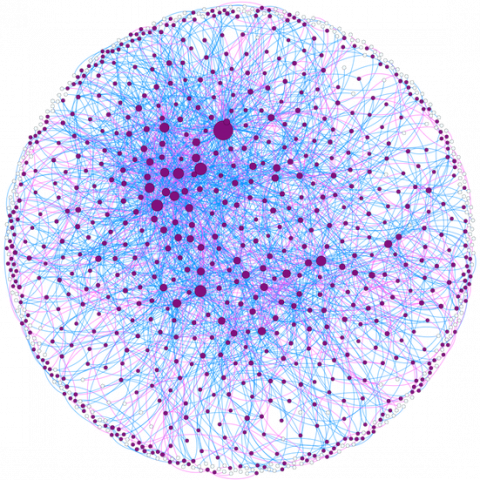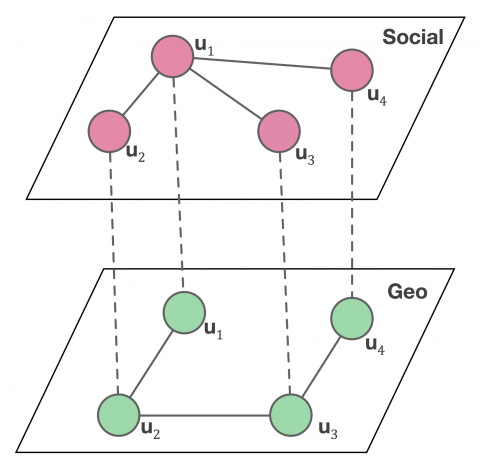Oliver Marsh is a PhD student at the Department of Science and Technology Studies, UCL. His thesis examines the use of social media by science enthusiast groups, with particular interest in how interactions spread meanings of ‘science’ and the ‘science identity.’ Previously he was at the Cambridge History and Philosophy of Science Department, studying the role of celebrity in science with reference to Carl Sagan and Richard Feynman.
From a display showing her own Facebook network as a series of circles and lines, Desislava Hristova, a PhD candidate in the Networks and Operating Systems Group of Cambridge’s Computer Laboratory, can pick out various influences on her life - her best friend of 11 years appears as a central highly-connected point, an overseas research group is a disconnected clump, and so on. The application of such network visualisations to social media research is a familiar one, but Hristova is most interested in its insufficiencies. As she points out, if we wish to go beyond visualisation and into important questions of how ‘we are all born into a social network [which] creates our context as human beings,’ then this social media data misses key figures – her mum, dad, teachers, and so forth – who are not on Facebook or are not among Hristova’s Facebook friends. The importance of these key figures to Hristova’s social network would only become visible if we plotted her network using other metrics – such as geographic co-location. To make such a plot would be straightforward. Less straightforward is working out how these two networks, the geographical and the social media, could be related to one another in a rigorous and generalisable fashion.

Image by Desislava Hristova
Hristova’s approach begins from abstraction, using mathematical models known as multilayer networks (Kivelä et al., 2014). In a multilayer network, each individual layer looks like a familiar graph – with objects represented by nodes and interactions shown by drawing edges between nodes – but the different layers are used to distinguish between different kinds of objects or interactions. So two layers may show the same individuals (nodes), but the edges connecting them represent online interactions on one layer and geographical proximity on another (see above image). Hristova focuses on multiplex networks, which also display connecting edges between layers. This approach has two main applications. Firstly, the multiplex graph can be flattened down in different ways to create various aggregate graphs. For example, one could create a new single-layer graph which shows all the edges from across the various layers (a union graph). This can show a richer picture of the multiple connections underlying a social group – bringing Hristova’s missing mum and dad into the graph of her social network. Alternatively, an aggregate graph showing only those nodes which are connected on every layer (an intersection graph) reveals those individuals who use multiple media to interact with one another.
The second general application of Hristova’s multiplex approach follows from this idea of media multiplexity, i.e. that the number of different media two people use to communicate with each other is an indicator of the strength of their relationship (Haythornthwaite, 2005). As in single-layer network analysis, often the key question is not whether connections exist but rather how strong they are. Looking at the number of connections actually employed between two nodes as a proportion of the number of connections that could be employed (i.e. the number of layers) allows a calculation of multiplex edge weight. This is a measure of strength of ties between nodes – a familiar value in network calculations – but one which takes all the layers into account.
From this basis, Hristova presented us with two specific applications of her approach. The first was a study of the online and (self-reported) offline networks of 74 college students, investigating homophily – the idea that, in the words of Plato, “similarity begets friendship” – across these two different forms of social space. This study showed that not only was multiplex edge weight a good measure of strength of friendship, but it could also be used to examine homophily (defined as “non-random similarity in pairs of connected nodes”) by measuring distance between nodes on a new graph weighted by multiplex edge weight. The results showed that, although the population as a whole was largely homogeneous with respect to political views and health, there was more diversity in music tastes – but those with stronger connections in the weighted graph were more likely to share music taste. In turn, multiplex edge weight was correlated to situational factors such as year and residence. In other words, even those living together were likely to use multiple media to connect with one another; multiple media indicated stronger friendship; and stronger friendship tended to be found between those with similar online profiles. The approach therefore teased out some of the relations between online and offline socialising, though still left questions of cause-and-effect open for further investigation.

Image by Desislava Hristova
The second study examined ‘brokerage’ – the act of mediating between otherwise disconnected individuals – by examining the online interactions and offline geographical check-ins of 37,722 Foursquare users in London. By looking at the union graphs connecting various users this research illustrated that only looking at one of geographical or online layers tends to either overestimate (as shown in the above image) or underestimate a user’s role as a broker. Underestimation was more common,and could be extreme – sometimes up to 100%. However, the results also indicated that while connections between online and offline users were plentiful, very few users were effective brokers in both offline and online settings. The importance of this study for social research relates to questions of social capital, as brokers can use their position as sources of information or control (Burt 1992, 2005). The discussion following this paper illustrated that, conversely, questions of social capital suggest developments to Hristova’s multiplex approach by raising questions around different forms of capital-developing interactions – humour, for instance, or political charisma. Nonetheless, it was clear that many of us in the room saw the utility of Hristova’s multiplex methods to our own work, as well as the stimulating possibilities for developing the model further.
